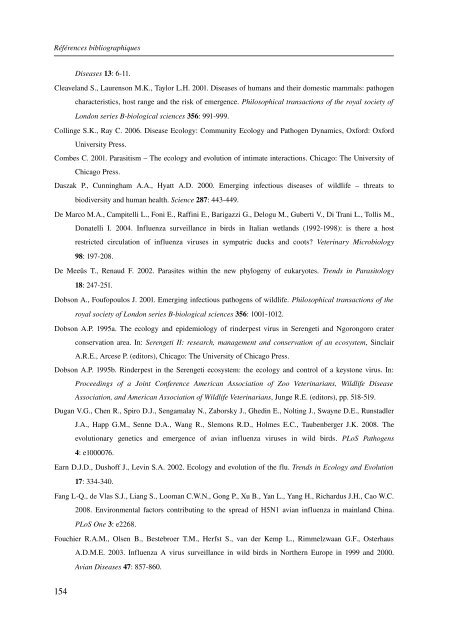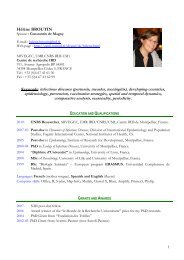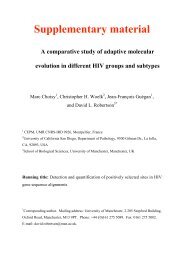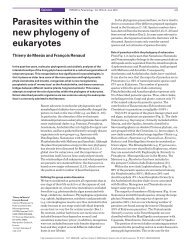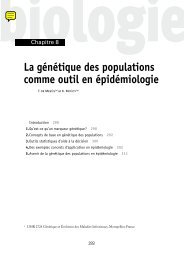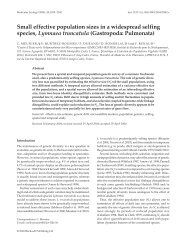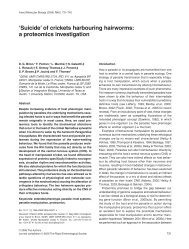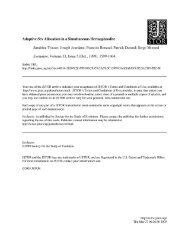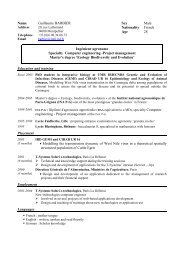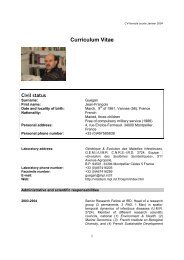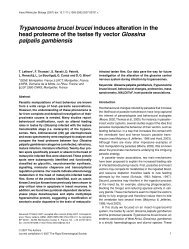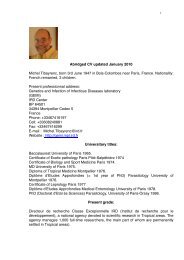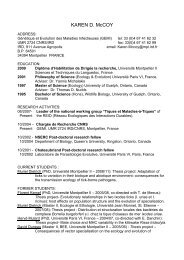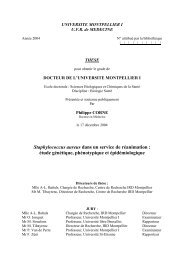Référ<strong>en</strong>ces bibliographiquesDiseases 13: 611.Cleaveland S., Laur<strong>en</strong>son M.K., Taylor L.H. 2001. Diseases of humans and their domestic mammals: pathog<strong>en</strong>characteristics, host range and the risk of emerg<strong>en</strong>ce. Philosophical transactions of the royal society ofLondon series Bbiological sci<strong>en</strong>ces 356: 991999.Collinge S.K., Ray C. 2006. Disease Ecology: Community Ecology and Pathog<strong>en</strong> Dynamics, Oxford: OxfordUniversity Press.Combes C. 2001. Parasitism – The ecology and evolution of intimate interactions. Chicago: The University ofChicago Press.Daszak P., Cunningham A.A., Hyatt A.D. 2000. Emerging infectious diseases of wildlife – threats tobiodiversity and human health. Sci<strong>en</strong>ce 287: 443449.De Marco M.A., Campitelli L., Foni E., Raffini E., Barigazzi G., Delogu M., Guberti V., Di Trani L., Tollis M.,Donatelli I. 2004. Influ<strong>en</strong>za surveillance in birds in Italian wetlands (19921998): is there a hostrestricted circulation of <strong>influ<strong>en</strong>za</strong> <strong>virus</strong>es in sympatric ducks and coots? Veterinary Microbiology98: 197208.De Meeûs T., R<strong>en</strong>aud F. 2002. Parasites within the new phylog<strong>en</strong>y of eukaryotes. Tr<strong>en</strong>ds in Parasitology18: 247251.Dobson A., Foufopoulos J. 2001. Emerging infectious pathog<strong>en</strong>s of wildlife. Philosophical transactions of theroyal society of London series Bbiological sci<strong>en</strong>ces 356: 10011012.Dobson A.P. 1995a. The ecology and epidemiology of rinderpest <strong>virus</strong> in Ser<strong>en</strong>geti and Ngorongoro craterconservation area. In: Ser<strong>en</strong>geti II: research, managem<strong>en</strong>t and conservation of an ecosystem, SinclairA.R.E., Arcese P. (editors), Chicago: The University of Chicago Press.Dobson A.P. 1995b. Rinderpest in the Ser<strong>en</strong>geti ecosystem: the ecology and control of a keystone <strong>virus</strong>. In:Proceedings of a Joint Confer<strong>en</strong>ce American Association of Zoo Veterinarians, Wildlife DiseaseAssociation, and American Association of Wildlife Veterinarians, Junge R.E. (editors), pp. 518519.Dugan V.G., Ch<strong>en</strong> R., Spiro D.J., S<strong>en</strong>gamalay N., Zaborsky J., Ghedin E., Nolting J., Swayne D.E., RunstadlerJ.A., Happ G.M., S<strong>en</strong>ne D.A., Wang R., Slemons R.D., Holmes E.C., Taub<strong>en</strong>berger J.K. 2008. Theevolutionary g<strong>en</strong>etics and emerg<strong>en</strong>ce of avian <strong>influ<strong>en</strong>za</strong> <strong>virus</strong>es in wild birds. PLoS Pathog<strong>en</strong>s4: e1000076.Earn D.J.D., Dushoff J., Levin S.A. 2002. Ecology and evolution of the flu. Tr<strong>en</strong>ds in Ecology and Evolution17: 334340.Fang LQ., de Vlas S.J., Liang S., Looman C.W.N., Gong P., Xu B., Yan L., Yang H., Richardus J.H., Cao W.C.2008. Environm<strong>en</strong>tal factors contributing to the spread of H5N1 avian <strong>influ<strong>en</strong>za</strong> in mainland China.PLoS One 3: e2268.Fouchier R.A.M., Ols<strong>en</strong> B., Bestebroer T.M., Herfst S., van der Kemp L., Rimmelzwaan G.F., OsterhausA.D.M.E. 2003. Influ<strong>en</strong>za A <strong>virus</strong> surveillance in wild birds in Northern Europe in 1999 and 2000.Avian Diseases 47: 857860.154
Référ<strong>en</strong>ces bibliographiquesFouchier R.A.M., Besterbroer T.M., Herfst S., van der Kemp L., Rimmelzwaan G.F., Osterhaus A.D.M.E.2000. Detection of <strong>influ<strong>en</strong>za</strong> A <strong>virus</strong>es from differ<strong>en</strong>t species by PCR amplification of conservedsequ<strong>en</strong>ces in the matrix g<strong>en</strong>e. Journal of Clinical Microbiology 38: 40964101.Fouchier R.A.M., Munster V., Wall<strong>en</strong>st<strong>en</strong> A., Bestebroer T.M., Herfst S., Smith D., Rimmelzwaan G.F., Ols<strong>en</strong>B., Osterhaus A.D.M.E. 2005. Characterization of a novel <strong>influ<strong>en</strong>za</strong> A <strong>virus</strong> hemagglutinin subtype(H16) obtained from blackheaded gulls. Journal of Virology 79: 28142822.Gaidet N., Dodman T., Caron A., Balança G., Desvaux S., Goutard F., Cattoli G., Lamarque F., Hagemeijer W.,Monicat F. 2007. Avian <strong>influ<strong>en</strong>za</strong> <strong>virus</strong>es in water birds, Africa. Emerging Infectious Diseases13: 626629.Gaidet N., Cattoli G., Hammoumi S., Newman S.H., Hagemeijer W., Takekawa J.Y., Cappelle J., Dodman T.,Joannis T., Gil P., Monne I., Fusaro A., Capua I., Manu S., Micheloni P., Ottosson U., Mshelbwala J.H.,Lubroth J., Dom<strong>en</strong>ech J., Monicat F. 2008. Evid<strong>en</strong>ce of infection by H5N2 highly pathog<strong>en</strong>ic avian<strong>influ<strong>en</strong>za</strong> <strong>virus</strong>es in healthy wild waterfowl. PLoS Pathog<strong>en</strong>s 4: e1000127.Gart<strong>en</strong> W., Kl<strong>en</strong>k HD. 1999. Understanding <strong>influ<strong>en</strong>za</strong> <strong>virus</strong> pathog<strong>en</strong>icity. Tr<strong>en</strong>ds in Microbiology 7: 99100.Gilbert M., Chaitaweesub P., Parakamawongsa T., Premashthira S., Ti<strong>en</strong>sis T., Kalpravidh W., Wagner H.,Sling<strong>en</strong>bergh J. 2006. Freegrazing ducks and highly pathog<strong>en</strong>ic avian <strong>influ<strong>en</strong>za</strong>, Thailand. EmergingInfectious Diseases 12: 227–234.Gilbert M., Xiao X., Pfeiffer D.U., Epprecht M., Boles S., Czarnecki C., Chaitaweesub P., Kalpravidh W., MinhP.Q., Otte M.J., Martin V., Sling<strong>en</strong>bergh J. 2008. Mapping H5N1 highly pathog<strong>en</strong>ic avian <strong>influ<strong>en</strong>za</strong> riskin Southeast Asia. Proceeding of the National Academy of Sci<strong>en</strong>ce USA 12: 47694774.Gortázar C., Ferroglio E., Höfle U., Frölich K., Vic<strong>en</strong>te J. 2007. Diseases shared betwe<strong>en</strong> wildlife andlivestock: a European perspective. European Journal of Wildlife Research 53: 241256.Greger M. 2007. The Human/Animal interface: emerg<strong>en</strong>ce and resurg<strong>en</strong>ce of zoonotic infectious diseases.Critical Reviews in Microbiology 33: 243299.Guan Y., Shortridge K.F., Krauss S., Webster R.G. 1999. Molecular characterization of H9N2 <strong>influ<strong>en</strong>za</strong><strong>virus</strong>es: were they the donors of the “internal” g<strong>en</strong>es oh H5N1 in HongKong? Proceeding of theNational Academy of Sci<strong>en</strong>ce USA 96: 93639367.Guernier V., Hochberg M.E., Guégan JF. 2004. Ecology drives the worldwide distribution of human diseases.PLoS Biology 2: 740746.Hanson B.A., Luttrell M.P., Goekjian V.H., Niles L., Swayne D.E., S<strong>en</strong>ne D.A., Stallknecht D.E. 2008. Is theoccurr<strong>en</strong>ce of avian <strong>influ<strong>en</strong>za</strong> <strong>virus</strong> is Charadriiformes species and location dep<strong>en</strong>d<strong>en</strong>t? Journal ofWildlife Diseases 44: 351361.Harvell C.D., Mitchell C.E., Ward J.R., Altizer S., Dobson A.P., Ostfeld R.S., Samuel M.D. 2002. Sci<strong>en</strong>ce296: 21582162.Hatchette T.F., Walker D., Johnson C., Baker A., Pryor S.P., Webster R. 2004. Influ<strong>en</strong>za A <strong>virus</strong>es in feral155
- Page 1:
UNIVERSITÉ MONTPELLIER IISCIENCES
- Page 7 and 8:
RemerciementsCette thèse est le fr
- Page 9 and 10:
RemerciementsJe remercie JeanPaul
- Page 11:
SommaireIntroduction. 11. Zoonoses
- Page 15:
Liste des annexesAnnexe 1 (p. 161):
- Page 19 and 20:
IntroductionIntroduction.En 2008, p
- Page 21 and 22:
IntroductionDe nombreux facteurs fa
- Page 23 and 24:
Introductionpourquoi le parasite es
- Page 25 and 26:
Introduction4. Objectifs et questio
- Page 27:
CHAPITRE I:ACTIVITÉS HUMAINES, PAR
- Page 30 and 31:
Chapitre I1. Activités humaines et
- Page 32 and 33:
Chapitre I12
- Page 34 and 35:
Chapitre I14
- Page 36 and 37:
Chapitre I16
- Page 38 and 39:
Chapitre I18
- Page 40 and 41:
Chapitre I20
- Page 42 and 43:
Chapitre I22
- Page 44 and 45:
Chapitre I24
- Page 46 and 47:
Chapitre I26
- Page 48 and 49:
Chapitre I28
- Page 50 and 51:
Chapitre I30
- Page 53 and 54:
Influenza aviaires en CamargueChapi
- Page 55 and 56:
Influenza aviaires en Camargue1.3.
- Page 57 and 58:
Influenza aviaires en Camarguebiolo
- Page 59 and 60:
Influenza aviaires en Camargued'hyb
- Page 61 and 62:
Influenza aviaires en Camargued'inf
- Page 63 and 64:
Influenza aviaires en CamargueP < 0
- Page 65 and 66:
Influenza aviaires en Camargue3.2.
- Page 67 and 68:
Influenza aviaires en CamargueArtic
- Page 69 and 70:
Influenza aviaires en Camargue47
- Page 71 and 72:
Influenza aviaires en Camargue49
- Page 73 and 74:
Influenza aviaires en Camargue51
- Page 75 and 76:
Influenza aviaires en CamargueArtic
- Page 77 and 78:
Influenza aviaires en Camargue55
- Page 79 and 80:
Influenza aviaires en Camargue57
- Page 81 and 82:
Influenza aviaires en CamargueArtic
- Page 83 and 84:
Influenza aviaires en CamargueAvian
- Page 85 and 86:
Influenza aviaires en CamargueIntro
- Page 87 and 88:
Influenza aviaires en Camarguedynam
- Page 89 and 90:
Influenza aviaires en Camarguemecha
- Page 91 and 92:
Influenza aviaires en Camargueand c
- Page 93 and 94:
Influenza aviaires en CamargueThese
- Page 95 and 96:
Influenza aviaires en Camarguela Re
- Page 97 and 98:
Influenza aviaires en CamargueJourd
- Page 99 and 100:
Influenza aviaires en CamargueEcolo
- Page 101 and 102:
Influenza aviaires en CamargueTable
- Page 103 and 104:
Influenza aviaires en CamargueFigur
- Page 105 and 106:
Influenza aviaires en CamargueOnlin
- Page 107 and 108:
Influenza aviaires en Camarguemodel
- Page 109 and 110:
Influenza aviaires en Camarguemigra
- Page 111 and 112:
Influenza aviaires en CamargueFigur
- Page 113:
CHAPITRE III:ÉMERGENCE DU VIRUS H5
- Page 116 and 117:
Chapitre IIIgénome de ces virus à
- Page 118 and 119:
Chapitre IIImigrateurs dans l'arriv
- Page 120 and 121:
Chapitre III96
- Page 122 and 123:
Chapitre III98
- Page 124 and 125:
Chapitre III100
- Page 126 and 127:
Chapitre III102
- Page 128 and 129:
Chapitre III104
- Page 130 and 131:
Chapitre III106
- Page 132 and 133: Chapitre III108
- Page 134 and 135: Chapitre III110
- Page 136 and 137: Chapitre III112
- Page 138 and 139: Chapitre III114
- Page 140 and 141: Chapitre III116
- Page 142 and 143: Chapitre III118
- Page 144 and 145: Chapitre III120
- Page 146 and 147: Chapitre IIIAbstractBackground: Sin
- Page 148 and 149: Chapitre IIIbeen victims of recurre
- Page 150 and 151: Chapitre IIIcombinations). Many var
- Page 152 and 153: Chapitre IIIdifferent families [2],
- Page 154 and 155: Chapitre IIIreported, in Bewick's s
- Page 156 and 157: Chapitre IIIunder the artificial co
- Page 158 and 159: Chapitre IIIfor Research and Techno
- Page 160 and 161: Chapitre III14. Butler D: Blogger r
- Page 162 and 163: Chapitre III28. Banks J, Speidel EC
- Page 164 and 165: Chapitre III44. SturmRamirez KM,
- Page 166 and 167: Chapitre IIIlocally and at a distan
- Page 168 and 169: Chapitre III144
- Page 171 and 172: Discussion générale et perspectiv
- Page 173 and 174: Discussion générale et perspectiv
- Page 175 and 176: Discussion générale et perspectiv
- Page 177: Discussion générale et perspectiv
- Page 181: Références bibliographiquesRéfé
- Page 185 and 186: Références bibliographiquesKilbou
- Page 187 and 188: Références bibliographiquesScott
- Page 189: ANNEXES
- Page 192 and 193: Annexe 1162
- Page 194 and 195: Annexe 1164
- Page 196 and 197: Annexe 1166
- Page 198 and 199: Annexe 1168
- Page 200 and 201: Annexe 1170
- Page 202 and 203: Annexe 1172
- Page 204 and 205: Annexe 1174
- Page 206 and 207: Annexe 1176
- Page 208 and 209: Annexe 1178
- Page 210 and 211: Annexe 1180
- Page 212 and 213: Annexe 1182
- Page 214 and 215: Annexe 1184
- Page 216 and 217: Annexe 1186
- Page 218 and 219: Annexe 1188
- Page 220 and 221: Annexe 1190
- Page 222 and 223: Annexe 2192
- Page 224 and 225: Annexe 2Ecology of ecosystems and p
- Page 226 and 227: Annexe 2Apparent competitionWith fe
- Page 228 and 229: Annexe 2rates decrease significantl
- Page 230 and 231: Annexe 2(e.g. light, humidity, temp
- Page 232 and 233:
Annexe 2between species, types of p
- Page 234 and 235:
Annexe 28 Sukhdeo, M.V.K. and Herna
- Page 236 and 237:
Annexe 2diversity. Trends Ecol. Evo
- Page 238 and 239:
Annexe 267 Park, T. (1948) Experime
- Page 240 and 241:
Annexe 2BOX1: Parasitemediated ap
- Page 242 and 243:
Annexe 2(a)(b)Box 2, figure I:panel
- Page 244 and 245:
Annexe 2Mature worms manipulate cri
- Page 246 and 247:
Annexe 2216
- Page 248 and 249:
Annexe 3218
- Page 250 and 251:
Annexe 3220
- Page 253 and 254:
Espèces échantillonnées, effecti
- Page 255 and 256:
Espèces échantillonnées, effecti
- Page 257:
Espèces échantillonnées, effecti


